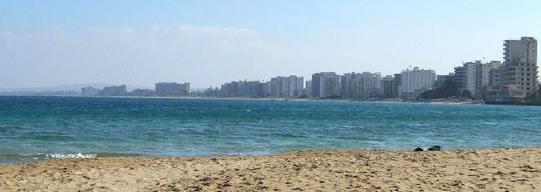
Famagusta is a city on the east coast of Cyprus and capital of the Famagusta District . It lies on the east coast in a bay between Capes Greco and Eloea, east of Nicosia , and possesses the deepest harbour in the island.The town was known as Arsinoe, after Arsinoe II of Egypt in antiquity, and mentioned by that name by Strabo , also as Ammochostos (meaning “hidden in sand”) which is how it is today referred to in Greek.
Famagusta is one of the most important, greatly fortified ports on the shores of the Mediterranean . To the north of Famagusta lie the fabulous ruins of Salamis . This one great city is believed to have been founded in the 11th century BC and after the influences of the many conquering nations -notably the Romans – the city was finally abandoned in 648 AD following the combined catastrophes of earthquake and raids by Arab pirates, when the population moved to Famagusta.
Famagusta has a very rich history, maybe the richest in all of Cyprus. It began as a small fishermen’s harbour, but during the de Lusignan period it became the island’s main port-of-call, with hundreds of ships anchoring there on their way to Europe or to the Holy Land.
Sites of interest
It seems to have had its heyday in the 13th century when Christians fleeing from Syria and Palestine settled there and developed it into a wealthy city under the Frankish Lusignan dynasty, which ruled from 1192 . It declined after a riot in the 14th century and by 1489 , when the Venetians took over, it had seen better times. They redeveloped it, building a massive wall round the old town, still mostly remaining. The Martinengo bastion is an excellent example of expert fortification , as it provides protection for the walls on either side of it. The Ottoman forces took over in 1571 , converting churches into mosques or using them for secular purposes. The Cathedral of St Nicholas became the Lala Mustapha Pasa Mosque.
The spectacular ruins give a fascinating insight into long-lost civilizations and include a magnificent amphitheatre, Roman baths, a gymnasium and royal tombs. The mosaics are particularly beautiful. Just inland from Famagusta are the church and monastery dedicated to St. Barnabas , the founder of the apostolic Church of Cyprus in 45 AD. Barnabas a Cypriot from Salamis, visited the island accompanied by St. Paul and St. Mark and was later martyred in Salamis in 52 AD. The church of St. Barnabas is preserved exactly as it was since abandoned in 1976. There is a wonderful collection of 18th century icons and the monastery cloisters now houses an archaeological museum.
The impression made by the formidable walls of this edifice is over- powering to even the most casual visitor. It was built by the Lusignans and further enlarged by the Venetians. The impression which is made by Famagusta harbour is reinforced by great citadel, otherwise known as Othello’s Tower, that thrills the visitors by its association with one of William Shakespeare ‘s best known plays. It contains a splendid l4th century Gothic Hall.
Also the Venetian Palace, which was used, after its destruction in 1571, during the Ottoman Empire as a prison, and among the prisoners was Namik Kemal , the National poet of the Ottoman Empire , who was held there between 1873 and 1876, after having been exiled to Cyprus by the Sultan .
Outside of the town you can visit the two Cypriot ancient towns, Enkomi and Salamis .
Enkomi was one of the first settlements in the east of Cyprus. Important for the production and export of copper during the Bronze Age. Finally destroyed at 1200 BC. Most of the population probably settled down on the coast where the first Greek settlers established the Kingdom of Salamis.
Salamis is believed that the ancient city of Salamis was founded by Teucer on his return from the Trojan War . During the Roman rule , Salamis was the greatest commercial centre of the Emporium in the East. In the 4th Century AD it was destroyed by earthquake, but was rebuilt and renamed Costantia by the Emperor Costantin. In 648 it was destroyed by Arab invaders and since then it has not been rebuilt. Salamis, the ancient city which lies beside the longest and one of the most beautiful of Cyprus’s sandy beaches, is found in an area which is partly forested. The Roman amphitheatre, the largest in Cyprus, can be visited with its Gymnasium, Baths and Market place. For further information see Salamis, Cyprus .
Source: en.wikipedia.org



